


Nalini Malani’s immersive animated installation at the National Gallery London plunges us into a world of bizarre figures, creatures, and energy waves that swirl and constantly change shape as they invade the complacency of the people in famous European paintings, bit by bit . Nalini Malini
(That’s a clip from the installation. It has to be downloaded, but it is short)

Chosen for the first National Gallery Contemporary Fellowship, gave Malani the opportunity for a new direction in her multimedia work. She selected a group of 24 paintings from the National Gallery, London, and several from the Holburne Museum in Bath, then bascially attacked them with dramatic animation drawings created with her finger on an ipad.
The amazing complexity of pattern, color, texture and image speaks to the artist’s command of this new medium which she has been working in for several years in short animations that she posted on Instagram.
The animations are agitated, threatening and occasionally playful.
We see only fragments of the original works.
The result is a dizzying array of images that are in constant motion, accompanied by a sound track that is a long lament by Cassandra who predicted the Fall of Troy, but no one believed her. What better mythic character for our times, when no one is changing their ways as we approach the precipice of no return on our climate
The overall theme is an attack on colonialism and white patriarchy based on the idea that “My Reality is Different”
So for example
Johann Zoffany’s The Auriol and Dashwood Families 1783 to 87
an image based on a painting of three influential families in Bengal India. The man in the green jacket on the right receiving a letter was an administrator of the East India Company. It shows the hierarchy of wealthy white British and their Indian servants
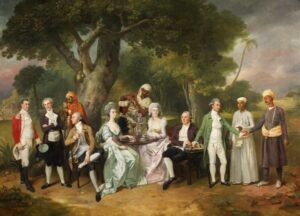

On the right you see clearly that same man with the green jacket, as well as some of the other members of his family, but the portrait is torn apart and basically undermined by Malani’s caricaturesque drawings.
Here is another example, harder to see. Caravaggio’s Supper at Emmeus and Malani overlay. You can see the detail of the Supper in the middle.
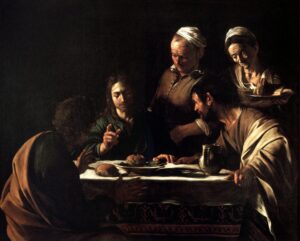
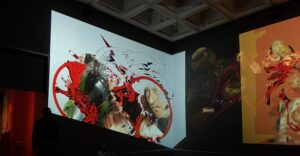
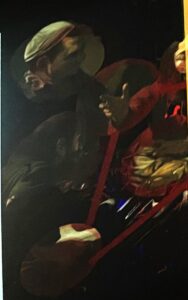
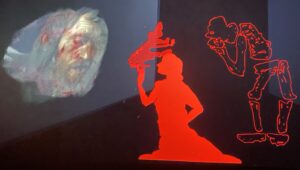
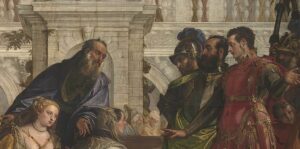
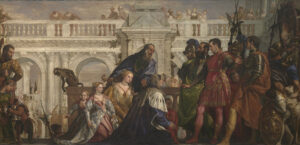
Nalini plucked the face of Darius from the huge painting by Veronese The Family of Darius before Alexander. The painting is an example of Alexander treating the defeated Persian king kindly, but the subject of course is imperialism as Alexander marched through country after country all the way to India.
Most of the source paintings Malini chose are examples of either arrogance, colonialism, or, in some cases feminism ( as in the Head of John the Baptist or Samson and Delilah).
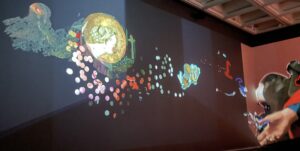
In the gold cirecle is only the head of the Angel Gabriel, half of an Annuciation scene from the 15th century.
Malani most frequently excerpts heads and hands from the original paintings, it is fun to spot them and trace them to the original works.
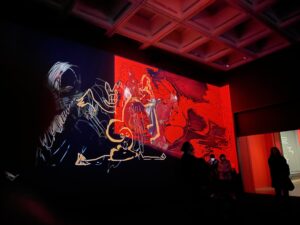
But of course that is so Eurocentric of me! The main point is the many many other figures that race through the video, and those shadowy portraits of people exist on the margins of this imperial world of white people.
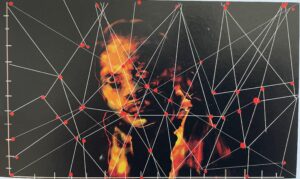
As you immerse yourselves in the room, surrounded on four walls by animation, the dizzying array of images overwhelms us ( that is the point). The source images disappear or flash by in small fragments as we see their decimation and fragmentaion.
The installation is an attack on Western imperialism as seen in these paintings full of complacent white people, conquerors, rapists and even a scientist suffocating a bird.
The artist projected a 9 channel installation in what she called the “animation chamber”. Each channel had three looped videos of about 3 minutes each. In the catalog she lists all the source paintings, but she illustrates only the ghostly figures who have been added by the artists so the “subaltern can speak”
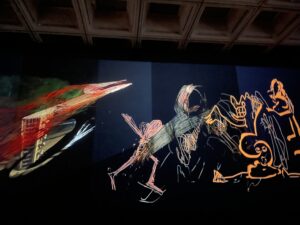
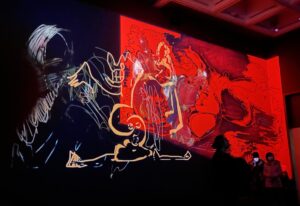
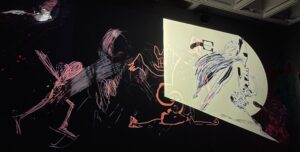
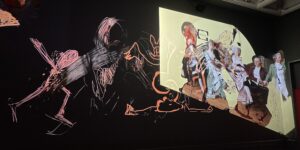
Here is a sequence that almost captures the effect of constant metapmophosis, you can recognize some repeated figures ( note creature in a heavy yellow outline, and running figure to left) and at the end the traces of that same painting by Zoffany of the East India families and their servants of color.
In addition to the layers of animations, the installation also includes a sound track, it of course is also consisting of several elements:
the sound of a sailing ship on the sea, “Rule Britannia” interrupted by a folk song sung by an Indian woman. Thefocal point, though, is the long chanted poem in the identity of Cassandra who is of course the prophetess of Troy who precidted its fall and no one believed her.
She could not be more pertinent today. ( it was adapted from Christa Wolf’s Cassandra:A Novel and Four Essays by the artist and Alaknanda Samarth)